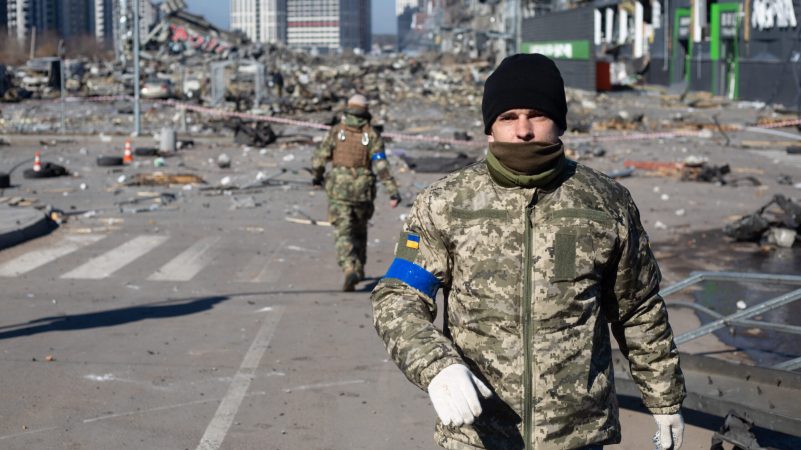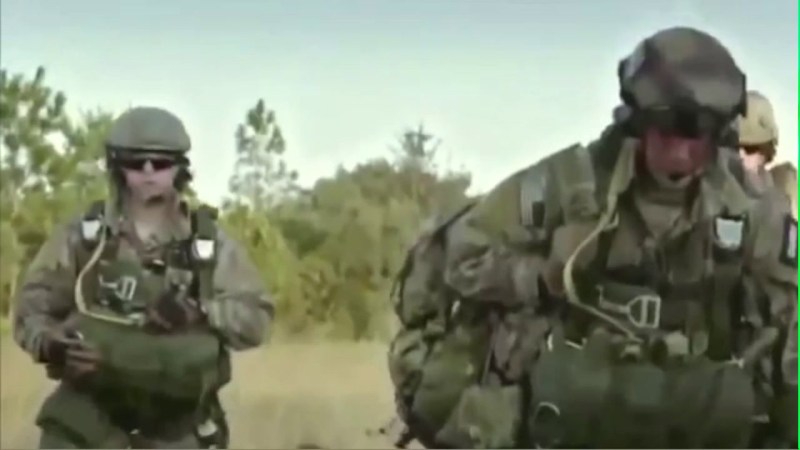It’s been a nightmare scenario for U.S. commanders for years: An amphibious readiness group sails stealthily towards its objective, one reckless Marine or sailor goes topside and uses a personal cell phone to check Facebook, revealing the position of the assault ship. The Chinese or Russians quickly detect the cell phone signal in the middle of the ocean and realize they can’t miss. The enemy fires its anti-ship ballistic or cruise missiles at Pfc./Seaman Schmuckatelli as he posts a meme and suddenly the entire ship along with thousands of sailors and Marines are lying on the ocean floor.
To some, this type of scenario may seem as hyperbolic as warnings that wearing white socks in combat could give away your location to the enemy, but Russian troops in Ukraine have shown the perils of using cell phones in modern-day warzones.
The Ukrainians claim to have killed 12 general Russian officers since late February, in part because the Russians have resorted to using cell phones when their communications systems break down.
“It is not hard to geo-locate someone on a phone talking in the clear,” retired Army Gen. Ben Hodges, former commander of U.S. Army Europe, told the New York Times.
Subscribe to Task & Purpose Today. Get the latest in military news, entertainment, and gear in your inbox daily.
When Russian troops cross into Ukraine, their cell phones emit a roaming signal that connects to Ukraine’s cellular network, allowing the Ukrainians to triangulate where the Russians are by using the closest three cell towers, said Artem Starosiek, CEO of Molfar, an open-source intelligence community based in Kyiv.
“So, the Ukrainian special services automatically receive information with the ID number of the device, roaming number, and, of course, the location of the person,” Starosiek told Task & Purpose. “Fortunately, Russians are quite naive and ignorant about using mobile devices, so they often call home, turning on their phones and connecting to the Ukrainian stations.”

The Russians have also given away their positions by stealing Ukrainian iPhones, which can be tracked using the Find My iPhone app, even when the phones are turned off, Starosiek said.
One Ukrainian man was able to use the “Find My” feature on Apple products to track the Russian troops who stole his AirPods, The Times of London reported. Vitaliy Semenets has posted on Instagram the path of the Russians as they retreated from Kyiv into Belarus and then repositioned in the Russian city of Belgorad, near Ukraine’s eastern border.
Amid numerous reports that the Ukrainians can track and target Russian troops when they use cell phones, one question remains: Why don’t the Russians destroy Ukraine’s cellular network?
The answer: They need it, said James Lewis, a technology expert with the Center for Strategic and International Studies think tank in Washington, D.C.
“That’s ridiculous, but that’s where it is,” Lewis told Task & Purpose. “The Russians need 3G and 4G for their comms to work. They didn’t set up the independent communications networks that the Americans or Chinese might have set up.”
While the Russians had developed encrypted communications handsets for their special operations forces, those handsets were not widely distributed among Russian troops before the latest invasion of Ukraine, Lewis said.
Corruption could be another factor that has played into why the Russian military has proven to be so poor at using secure communications, he said.
“There are good examples – not always public – of the Russians identifying a security goal and then allocating, in one case, $10 billion to it; and $5 billion of it ended up in Switzerland,” Lewis said.
The Russians also did not adequately plan for the invasion because they honestly thought that the Ukrainians would welcome them as liberators, he said. The combined effects of the corruption, poor planning, and resulting logistical problems is that there are now many images online showing Russian troops using cell phones or even the type of unencrypted walkie talkies that you could purchase at toy stores.
Looking at the Russian failures in Ukraine so far, it’s tempting to think the militaries of NATO members wouldn’t make the same mistake, but they have. In November, Polish troops that had been deployed to the border with Belarus left the dating apps on their cell phones on. Just across the border in the city of Grodno, the Belarusians knew exactly how far away the Polish troops were.
U.S. troops are far from immune to unintentionally revealing their positions by using mobile devices. In 2018, a company that gathers data from consumer fitness devices such as FitBits revealed that American service members were essentially drawing GPS maps of their bases in the Middle East and Afghanistan every time they went running.
Later that year, the Defense Department banned troops from using cell phones, fitness trackers, and other devices that use geolocation features, and now many offices in the Pentagon require people to leave their cell phones in lockers outside. A subsequent New York Times investigation revealed that companies can track people’s smartphones inside the Pentagon by using software on mobile phone apps.
The Russians’ experience in Ukraine is a warning to U.S. troops about what can happen if they act carelessly. In 2020, a bored Marine lance corporal got his entire artillery unit “killed” during an exercise at Marine Corps Air-Ground Combat Center Twentynine Palms, California, when he used his cell phone to take a selfie, Military.com reported.
“The Marine Corps understands signature management must be incorporated into planning efforts and training,” said Marine spokesman Maj. Gregory Carroll, who added that the Corps will soon release its new doctrine on information warfighting.
“A passive way to deny the opponent vital information is to selectively alter or suppress the visual, electromagnetic, and digital signatures emanating from friendly forces,” Carroll said. “This includes implementing operations security measures, communication discipline, camouflage, counterintelligence, and signature management.”

Soldiers are also trained to turn off Bluetooth and Wi-Fi radios when not using them, encrypt sensitive files, and only download trusted apps, said Maj. Andrew Harshbarger, a spokesman for Army Training and Doctrine Command. Soldiers’ mobile devices can also be disabled and confiscated when necessary.
The U.S. military has been concerned about troops inadvertently revealing their positions by using cell phones long before Russia attacked Ukraine in late February.
Commanders have known for years that U.S. troops forces have lost their fieldcraft skills at hiding their electronic, thermal, infrared, and visible signatures, said retired Gen Robert Neller, the former Marine Corps Commandant.
“We need to make the adversary work to find us – we can’t make it easy for them to find us,” Neller told Task & Purpose.
Neller recalled how Marines used to stay in touch with their families while in the field and on deployments by sending and receiving mail. While modern technology has made it easier for troops to stay in touch with loved ones, it has also created a new series of problems.
A few years ago, the I Marine Expeditionary Force conducted an exercise to find out which part of the base had the largest electromagnetic signature, he said.
“The most readily apparent thing from high overhead was the billeting area, where people were living, because they all were using their phones,” Neller said.
While Marines have improved at concealing their electronic signatures, they need to remain concerned about unintentionally revealing their positions, said Neller, who noted that even PlayStations can be detected by adversaries because they are networked.
“I don’t understand why people don’t understand,” Neller said. “If I can find you, I can target you; and if I can target you, I can shoot you; and if I can shoot at you, I can kill you. It’s pretty simple.”
The latest on Task & Purpose
- The Marine Corps is headed for a pilot exodus
- ‘The king of battle’ — How US artillery in the hands of Ukrainians may reshape the war with Russia
- Marine intel instructors got caught calling students ‘whore’ and ‘slut’ in private chat. No punishment was recommended
- How to pass the new Air Force fitness test, according to a guy who oversaw 600 of them
- ‘Dirt boyz,’ ‘Port Dawgs,’ and ‘Red Horse’ — A guide to Air Force lingo for the rest of us
Want to write for Task & Purpose? Click here. Or check out the latest stories on our homepage.

























